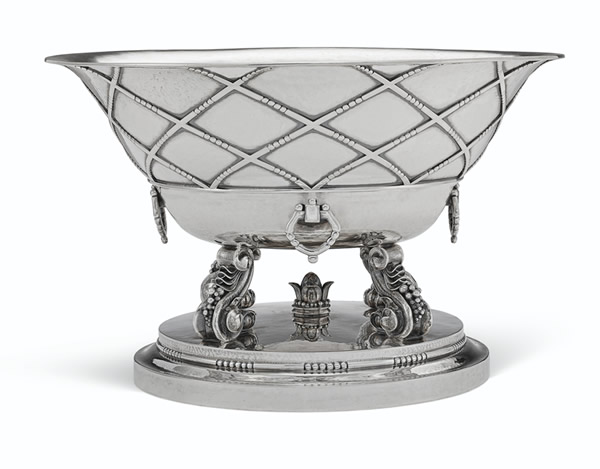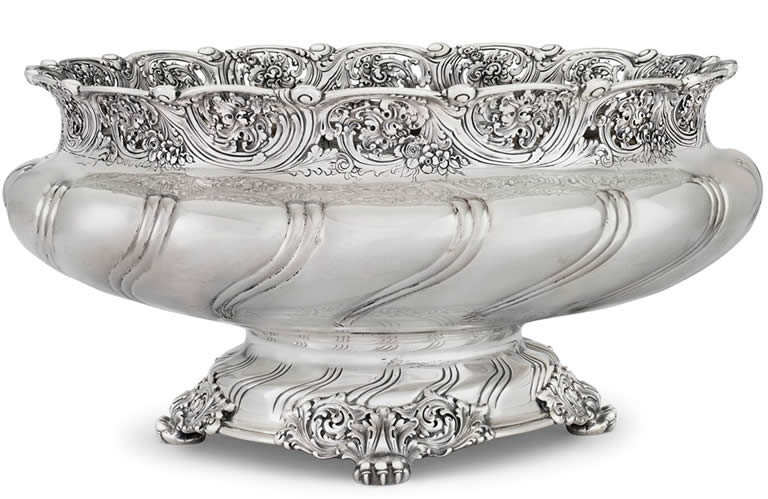Silver Dish Restoration in London
Bringing Back Functionality and Elegance
Silver dishes are versatile, functional, and elegant additions to any table setting, often used for serving fruits, snacks, or as decorative pieces. Over time, however, they may become tarnished, scratched, or suffer from wear due to frequent handling and exposure to air, moisture, and cleaning products. Restoring silver dishes ensures they retain their original beauty and usefulness, allowing them to continue being admired and utilized for generations to come.


The Value of Silver Dish Restoration
Restoring a silver dish is an investment in preserving its beauty, functionality, and value. Whether it’s used as an elegant serving piece, a cherished family heirloom, or an antique collectible, restoration ensures it continues to serve its purpose and maintain its visual appeal. A well-restored silver dish can be passed down through generations, maintaining its role as both a practical and decorative item in your home.
Silver dish restoration helps preserve the timeless elegance of these pieces, ensuring they remain an integral part of any table setting or collection.
When to Seek Professional Restoration
While minor tarnish removal and surface cleaning can be done at home, there are cases when professional restoration is recommended:
- Extensive Tarnish or Oxidation: If tarnish is deeply ingrained or if the dish has oxidized in intricate designs, professional cleaning is necessary.
- Deep Scratches or Structural Damage: For severe scratches, dents, or misshapen areas, professionals have the tools to repair and restore the dish to its original form.
- Plating Loss: Silver-plated dishes with significant wear may require professional replating to restore their finish.
- Antiques or Collectibles: If the dish is a rare antique or holds collectible value, expert restoration ensures that the work is done carefully and without diminishing its value.
Common Issues with Silver Dishes
Silver dishes, whether decorative or functional, can face a variety of issues over time:
- Tarnishing: Silver naturally tarnishes when exposed to air, causing it to lose its gleaming shine and turn dull or yellowish.
- Scratches: Frequent use or improper cleaning can result in surface scratches, especially if the dish is used for serving or handling rough items.
- Dents and Dings: Accidental drops or rough handling can cause dents, dings, or misalignment, affecting both appearance and functionality.
- Plating Wear: Silver-plated dishes may lose their thin layer of silver, revealing the base metal beneath.
- Stains or Residue: Depending on the dish's use, it may accumulate stains from food, or residue from cleaners may affect its finish.
- Oxidation: Over time, oxidation may settle into the grooves and intricate designs, making it harder to clean and dulling the details.
Why is Silver Dish Restoration Important?
Restoring a silver dish offers both aesthetic and functional benefits. Here's why restoration is important:
- Aesthetic Appeal: Restoration revives the original shine of the dish, restoring its visual appeal and preserving intricate details, whether it’s a smooth surface or ornate pattern.
- Functionality: Proper restoration ensures the dish remains fully functional, whether used for serving or as a decorative piece, preventing further damage.
- Preservation: Timely restoration prevents the dish from deteriorating further, ensuring it lasts for future generations and maintains its value.
- Sentimental or Collectible Value: Many silver dishes are heirlooms or collectibles with personal significance, and restoration helps preserve these precious items.
The Process of Restoring Silver Dishes
Restoring silver dishes involves careful cleaning, repairing, and polishing to preserve their appearance and function. Here's the typical restoration process:
- Inspection and Assessment
The restoration process begins with a detailed inspection. This includes checking for tarnish, scratches, dents, wear on the plating, or any damage to the dish’s surface or structure. - Cleaning the Surface
Silver dishes are carefully cleaned using a mild soap solution and warm water, followed by wiping with a soft cloth to remove dirt, dust, and grime. For ornate dishes, a soft brush may be used to reach difficult-to-clean areas without damaging the intricate design. - Tarnish Removal
Tarnishing is often the most visible issue with silver dishes. Specialized silver polish or natural solutions like a baking soda paste are applied to gently remove tarnish and restore the silver’s natural shine. Care is taken not to remove oxidized accents or intricate designs in the process. - Repairing Scratches, Dents, and Dings
Surface scratches and minor dents are carefully repaired. Dents are worked out using specialized tools that restore the dish’s flat shape and structure. If the dish is bent or misshapen, the metal is carefully manipulated to bring it back into alignment. - Replating (If Necessary)
For silver-plated dishes, if the plating has worn thin, a new layer of silver may be applied using electroplating. This process restores the dish’s original appearance while protecting it from future damage. - Polishing and Finishing
Once repairs and cleaning are complete, the dish is polished to bring out its shine. This final step enhances the dish’s luster and highlights its detailed designs, ensuring it looks as good as new.
Maintaining Restored Silver Dishes
To keep your restored silver dish in pristine condition, consider the following maintenance tips:
- Regular Cleaning: Gently wipe down the dish after use to prevent the buildup of dust, moisture, and fingerprints.
- Avoid Abrasive Cleaners: Only use non-abrasive cleaning solutions to prevent scratching or damaging the surface.
- Proper Storage: Store the dish in a dry, tarnish-resistant cloth or pouch to minimize exposure to air and humidity.
- Handle with Care: Handle silver dishes with clean hands to avoid oils that may cause tarnishing. Be cautious not to drop or knock the dish to prevent further damage.
Information for Caring for Silverplate Flatware
1. Hand Wash Only
The normal advice for all plated flatware is to avoid washing it in the dishwasher. Wash your plated silverware by hand, in warm soapy water, with a soft sponge or cloth, then rinse and dry with a dry, clean towel. Don't use harsh chemicals or gritty products. Don't over-scrub or wash too often.
2. Use the Right Soap
Any mild dish soap should do, but make sure to use an acid-free soap or detergent with a neutral pH that is free of phosphates and does not contain lemon or another citric acid, as those ingredients can be overly corrosive.
3. Rinse Quickly
Wash silver-plated flatware as quickly as possible after use. At the very least, rinse to remove food from the items after use and don't let them sit dirty. Acidic foods (egg yolks, brussels sprouts, table salt, olives, salad dressing, vinegar, fruit juices, etc.) can corrode silver if left in contact with it for too long.
4. Dry Carefully
Water is the enemy of silverware. Don't leave your plated ware soaking in water for too long, and make sure to dry it thoroughly with a soft cloth as soon as possible to prevent tarnish.
5. Do NOT Over polish
Surprisingly, silver flatware does not need regular polishing and should not be cleaned or polished more than absolutely necessary. Instead of using a chemical polish, if it looks just a little dull, use a polishing cloth. If you care for and store the silverware properly, you will reduce the build-up of tarnish and the need to use polish. Only use silver polish when absolutely necessary, or you'll rub the silver plate off the silverware.
What About the Knife Blades?
Remember that your flatware knife blades will most likely be stainless steel, and they should be cleaned with that metal in mind.
6. Avoid Abrasives
On the occasions when you do need to polish your silverplate flatware, only use a good quality silver polish or cream, not a standard metal polish, which will be too abrasive. If you need to, use a brush with very soft bristles for crevices. Do not, under any circumstance, use wire wool or abrasive cloth to remove stains; this will scratch and damage the silver. As mentioned, polish as seldom as possible since a small amount of metal will be removed each time.
7. Do Not Use Rubber or Latex Gloves
If you wear gloves, make sure that they are made of cotton because rubber gloves contain sulphur that may promote tarnish. Don't wear rubber or latex gloves, and don't let clean silver touch a rubber drying mat.
8. Store Properly
It is important to store your silver flatware properly to prevent scratching, corrosion, and tarnish. Wrap your flatware in tarnish-resistant flannel cloth, acid-free tissue paper, or undyed cotton or linen, or keep it in a flannel-lined drawer. Since air is the cause of tarnish, make sure to keep it in an airtight container. If you don't use it every day, consider storing it in a zip-top plastic bag (Note: don't use rubber bands and avoid storage boxes or chests with rubber seals.)
Silver Repairs, Restoration & Silver Plating by post
Send us your silver for restoration, repairs or silver plating with ease! Simply click the button below to download our "Send by Post" Repair Form. Complete the form and mail your silver item to us. Once repaired, your item will be returned to you securely via Special Delivery.
Let us handle your silver with the care it deserves, no matter where you are!

